
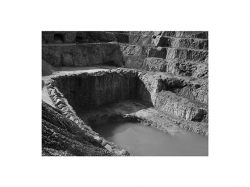
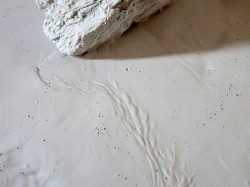
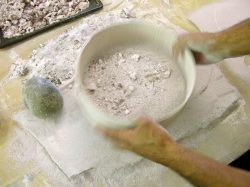
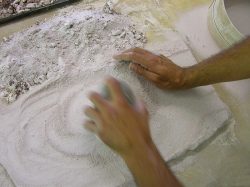
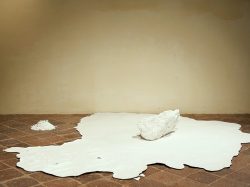
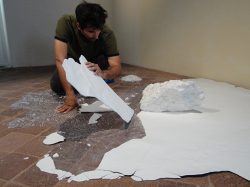
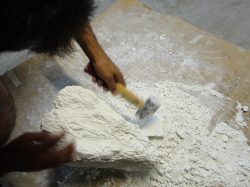
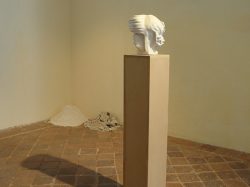
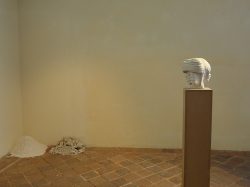
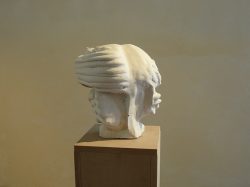
Click the button below and fill out the form with your details. Our team will get in touch with you to give you all the information you are looking for.
Request Data Sheet Project MartaGypsum-Plaster is a project connected to an important step in the research of Caretto-Spagna duo, a stage defined by a period of residence in 2008, the result of a collaboration between the small museum of contemporary arts in Digne and the geological museum situated in the largest park in Europe, the Géologique Réserve de Haute-Provence.
Gypsum-Plaster is the arrival point of the duo in terms of knowledge of the subject, a result of the awareness of basic steps such as the choice of a mineral plaster block which is then pulled down, baked and milled. The obtained powder (canary grass), mixed with water, is then poured in the mold.
The object appears to be a copy of the source rock, but shows differences in colour, texture and crystallization, while the cast to the ground is the result of excess plaster resulting from the transformation process, materialization of the energy used by the artists in processing.
Phase 2 of the project see the artwork being destroyed at the end of the exhibition, and the process can be repeated, so that other artists can create a new sculpture from the same amount of canary grass originated from the first one. The first were Allis / Filliol, the next artist invited to create the phase 3 is Fabrizio Prevedello.
Excerpts from the technical interview to Andrea Caretto and Raffaella Spagna:
“We started both with an academic background – Caretto in sculpture, Spagna in painting – but we left that artwork component into the studio to experiment with other forms of production more closely linked to the action, where the heart of the aesthetic is ” being there” in carrying out the action, which is then documented or returned with installations. In this case we can say that we have rediscovered – even if it is never diminished the pleasure of having to deal with the matter in person – the degree zero of sculpture, we found ourselves with a certain amount of plaster that could take on any shape and at that point we said that we could go all the way to the transformation process, to explore the line between the instinctive pleasure of transforming the matter and the responsibility of creating something new. “
“We thought that with respect to our artwork Allis / Filliol would have put a distance in order to operate while maintaining a strong contact with matter, a closeness that we imagine will decrease with the progress of this project, which will involve sculptors very different from us . The idea of using this issue by exploring the infinite possibilities that the man has to offer is the concept behind the artwork,being aware that it will return to its “dusty” condition and that its characteristics will change, as it will become impalpable, the setting time will no longer be the same, it will become harder. “
“It was certainly a very long work, because we have personally turned the gypsum blocks, learning something more by grinding with stones, observing how matter behaves when water is added, how it should be sifted, the time required, starting to realize if the oven temperature was correct, if we had shot well the material or not … “
“In general we are not obsessed with the preservation of form, its crystallization into a definitive structure. Often our artwork is the evidence, a search field, we sometimes have no experience and do not know how it will change and how quickly. Often the show is a laboratory as much as the workshop, because spaces are not equipped to accommodate the trials. “